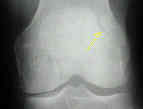- See: multipartite patella
- Discussion:
- a common congenital fragmentation or synchondrosis of the patella
- occurs in approximately 1% of population but some have observed a much higher incidence;
- most remain asymptomatic, but direct trauma may disrupt the synchondroses, causing symtoms that mimic those of fracture;
- classification:
- type I: inferior pole of the patella;
- type II: lateral margin type;
- type III: superolateral type;
- diff dx:
- stress frx: look for verticle fracture line;
- Sindig-Larsen-Johanssen disease may resemble a type I bipartite patella;
- patellar sleeve fracture
- osteochondral frx:
- is distinguished from biparte patella:
- on basis of history of trauma;
- hemarthrosis of knee;
- point tenderness over defect
- distinct outline of frx on radiographs;
- unilateral defect (less than 45% of patients will have bilateral bipartite patella);
- rapid resolution of symptoms w/ fracture (w/ immobilization);
- Treatment:
- type I patella:
- patient with type I bipartite frx (lower pole) may at risk for fracture;
- patients that present with pain and tenderness at the lower pole, should have all activites curtailed;
- fractures occur along the synchondrosis and when displaced, operative fixation is considered;
- type III patella:
- superolateral bipartite patellae may become symptomatic and in some cases may require excision;
- also consider limited detachment of vastus lateralis from the bipartite fragment which removes the stress on the fragment and which can allow spontaneous union
Painful Bipartite Patella. A New Approach to Operative Treatment.
Excision of Painful Bipartite Patella: Good Long-term Outcome in Young Adults.
Other links:


